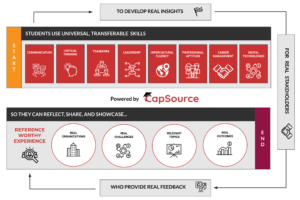
Guiding Questions to Help Strengthen Experiential Education Across your Institution
The value of experiential education has gained renewed attention in the midst of the growing skills gap among college graduates and apparent disconnect between academia and industry. Experiential education gained popularity in the 1980’s and has since become an integral part of higher education as an approach for furthering educational and career goals of students. Recent discussions on the rapid changes in the economy, widening employment skills gap in college graduates, and the perceived disconnect between industry and academia have raised questions as to how institutions can strengthen the role of experiential learning by extending its reach across the institution and student experience.
What is Experiential Learning?
David Kolb’s (1984) conceptualization of experiential learning is one of the most widely recognized and influential
approaches to teaching and learning. In his theory on experiential learning, Kolb describes learning as a four-stage circular process involving concrete experience, purposeful reflection, abstraction, and active
experimentation (or “now what”). Though emphasis tends to be placed on the “hands-on”, “direct experience” quality of the process, reflection is critical for learning as it helps the learner make the connection between the
concrete experience and the learning and meaning derived from that experience (Denton, 2011). The table below compares a number of characteristics of experiential learning to those associated with traditional learning approaches:

How does Experiential Learning Compare to Traditional Approaches?
What are the benefits of experiential learning for development?
The benefits of the approach for learning and development are well documented. Among its contributions, experiential learning:
- Facilitates mastery of concepts and practice through the process of direct experience, reflection, abstract generalization, and experimentation through new experiences.
- Accelerates learning and develops higher order thinking skills for critical thinking and problem solving as feedback is immediate and natural as opposed to detached and manufactured.
- Increases motivation for learning, as learners are active participants in the design, implementation, and management of their own learning.
- Supports the transition to adulthood by integrating ideas and actions into the larger community and developing skills for citizenship.
- Contributes to the development of a productive and well-educated workforce that not only possesses the general competencies and specialized skills needed for the workplace, but has the ability to manage their own learning independently in order to meet changing needs of employers and the economy.
Sources: Hesser, 2013; Kendall, Duley, Little, Parmaul, and Rubin, 1986; Kolb, 1984; Kolb & Kolb, 2005;

Educators and academic programs have adopted a range of strategies for immersing students in industry-integrated learning experiences, and encouraging their reflection about the experience to develop new skills, attitudes, and behaviors. Industry-Integrated Experiential Learning (IIEE), like the type of programming CapSource designs with their network of academic and industry partners, refers to a pedagogical approach for enhancing the employability of students “by providing real-world learning experiences through purposefully designed curriculum which encompasses authentic interaction with industry/community stakeholders” (Ferns et al., 2021, para. 2). Service learning, internships, pratica, and course-embedded or capstone projects, along with techniques like project-based learning, simulations, field observations, group learning, and peer-led instruction provide a range of options for structuring experiential learning across the student experience and ensuring the breadth, depth, and complexity of workforce skills are reflected in a holistic student learning experience.

Even so, the need for colleges and universities to more fully integrate industry-integrated learning across the student experience has not yet translated into a widespread shift away from traditional teaching methodologies. Institutions and educators are being challenged to move experiential learning beyond an “add-on”, “extracurricular”, or other isolated part of the curriculum to educate students for the future. Embracing industry-integrated experiential learning pedagogies requires changes in thinking, practice, and organizational structure across academic and industry stakeholders (Ferns et al., 2021). As CapSource previously covered in the article, “The Role of Institutions in the Experiential Bargain,” utilizing the full value of this approach to learning and development involves collaborative partnerships with business, industry, government and community organizations and a comprehensive integration of experiential education across institutional functions.

Institutionalizing Industry-integrated Experiential Learning
For those looking to strengthen the role of experiential learning and academic-industry partnerships as integral to each students’ education, this challenge no doubt presents itself as an enormous, complex undertaking. It necessarily involves a wide range of the college’s ongoing systems – its mission and values, academic policies, degree requirements and curriculum, administrative structure, compensation, budget, and all levels of evaluation. Moreover, the process of integration has the potential to augment opposition and conflict between the values, perspectives, and norms of different stakeholder groups and systems within the social organization of the institution (LaCroix, 2021). On the other hand, the institutionalization of experiential education has the potential to give rise to systems that “reconcile opposing and conflicting priorities, such as faculty priorities of research and practice, and administrative priorities oriented to skill development and career readiness” (p. 11).
Where and how can institutions, academic programs, educators and college leaders take action to strengthen Industry-Integrated Experiential Learning across the student learning experience? One strategy is to begin by examining how ongoing systems of the college are organized in relation to this style of collaborative learning principles, best practices, and goals. Asking – and answering – questions about the institution’s current capacity for expanding experiential learning policies, structures, processes, and practices in one’s own position, department, committee, and so on can help leaders and groups account for the good work already in motion and more clearly define the organization’s strengths and opportunities for industry-based experiential education. It also provides the much needed space to engage internal and external stakeholders with their own set of as partners in change management to strengthen experiential learning at the institution. This approach also affords opportunities for incremental, rather than sweeping changes, as part of an ongoing process for improvement and innovation.

In keeping with CapSource’s inquiry-based approach to industry challenges, we identify several strategies and tactics, written in the form of guiding questions, that stakeholders can engage to transform key ongoing systems across the institution. While the list of strategies and tactics is not exhaustive, it does offer change-makers and stakeholders at all levels of the institution a set of strategic priorities and action steps that can be tailored to the organizational structure and used to strengthen industry experiential learning as integral to students’ education…








Increase alignment between the institution’s mission and strategic goals.
- How is experiential defined at the institution, and to what extent is there alignment between the college’s mission and values and industry-integrated experiential education?
- How can the institution educate stakeholder groups on the value IIEE delivers and its impact on key institutional performance outcomes?
- What strategic priorities and initiatives may be advanced using IIEE approaches and strategies?
- How do industry-integrated experiences add value for diversity, equity and inclusion? How is equity in access to industry-integrated opportunities considered and assessed?
- To what extent are IIEE strategies and programs evident in the institution’s marketing strategy?
Capitalize on mission-aligned networks in the institutional environment.
- What external networks can be leveraged to validate the legitimacy, uniqueness, and value of the institution’s IIEE programs and practices?
- What tools, like CapSource’s Experiential Learning Management System, might be helpful as you look to organize and activate your industry network?
- What legal issues are relevant to industry-based experiential learning? Is there guidance for staff, faculty, and administrators seeking out expert advice and assistance?
- What opportunities exist to forge local, regional, remote partnerships with industries and other institutions for advancing IIEE at the college?
- What role can alumni serve in expanding industry-integrated mentoring experiences?
Ensure academic policies and structures support experiential education.
- Are industry-integrated learning experiences credit bearing? Are criteria used to assign credit value consistent across academic programs?
- Are IIEE programs documented as part of the student’s official academic transcript?
- Is there written guidance (handbooks, templates) for each stakeholder group to successfully navigate the field placement process?
- In what ways do academic requirements for industry-integrated learning differ across academic programs?
- How up-to-date is your inventory on the breadth of experiential learning programs that involve industry-integrated learning?
Make industry-integrated experiential education a purposeful part of assessment and evaluation.
- In what ways do IIEE programs and practices contribute to compliance with accreditors?
- Is experiential learning a purposeful part of program review processes, and offer guidance and frameworks for reporting impacts and outcomes? How are impacts on student learning and program outcomes measured and benchmarked?
- To what extent do formative and summative assessments encourage learners to self-evaluate their own progression or success in the learning process? (Explore CapSource’s Multi-Source Evaluation Approach for reference)
- How does industry-integrated learning contribute to student outcomes in quantitative and qualitative ways? Can you develop case studies to show how industry-based learning is integrated across the curriculum from onboarding to graduation?
- How might you be able to better collect, analyze, and share data related to your IIEE programs?
- What does a needs assessment reveal about gaps in technologies to support the design, development, implementation, and evaluation of IIEE across the student learning experience?
Increase the value of experiential teaching in the recruitment, compensation, evaluation, and promotion systems.
- How is the institution’s value of experiential education evident in the employee recruitment process (job announcements, interview schedules)?
- To what extent are principles of experiential teaching and learning reflected in the evaluation of instruction, teaching, and advising effectiveness?
- How do performance expectations of staff, managers and administrators take into account their important roles for supporting IIEE and other experiential learning strategies across the student experience?
- In what ways is experiential learning reflected in the compensation, workload, and promotion systems of the college? Are incentives and rewards at least comparable to those gained through other teaching methods?
- Do sabbatical award programs, internal grants, stipends, and similar programs offer support for faculty and staff to innovate and enhance experiential learning in curricular and extra-curricular student experiences and programs?
Facilitate cross-department communication, coordination, and collaboration on experiential learning initiatives and programs.
- How can non-teaching administrators and staff redefine their roles to include, at minimum, advocacy for experiential education? How can they meaningfully add value to college experiential learning initiatives?
- What is the most effective administrative model for managing experiential education programs at your institution?
- Is the coordination of programs centralized to an institutional office, distributed among multiple offices, and/or under the direction of departments offering programs and courses?
- Is there a college-wide advisory committee organized for advancing experiential education?
- What opportunities are there for cross-department sharing of information and resources for experiential education?
- What roles does the curriculum committee perform in supporting experiential education? What are the relationships between this and other committees, task forces, and positions supporting experiential education?
Engage faculty to promote interdisciplinary collaboration, curricular agility, and shared governance.
- Are faculty invited to engage in conversations and work that deepens and expands the quality of education for students?
- What is the role of faculty and staff in preparing students for learning in industry-based contexts?
- Who are the natural leaders among the faculty that can advocate for EXL to and for the institution?
- What opportunities are there for faculty to showcase teaching and learning scholarship, and mentor best practices for developing general education competencies using experiential learning strategies?
- Who among the faculty are engaged in research on teaching and learning? What resources are available to support their research and the dissemination of their work?
Empower students as agents in the development of their knowledge and skills.
- How and when are students oriented to experiential learning, its application, and its value to their education?
- To what extent do students reflect on their own learning styles and bear responsibility for and take ownership over their own learning? How is this facilitated?
- What opportunities do students have to experience the full process of learning according to Kolb’s model? Where are these opportunities occurring in the student learning experience?
- Are learning spaces designed to stimulate inquiry and create good learning conversations?
- How much input do students have in the placement decision-making process for internships, service-learning, practica, etc.?
- What channels are used to communicate with students about resources for finding, landing, and preparing for field placement or other industry-based learning opportunities?
- What grants, fellowships, and other funding resources are available to support student internships and fieldwork? How do these help close the gap in access to opportunities for traditionally underserved and economically disadvantaged populations?
- How is student excellence in experiential learning modeled and reinforced?
We hope the frameworks, strategies and tactics offered here enable you to more effectively analyze and reflect on your institution’s capabilities when it comes to offering students meaningful experiential learning opportunities that result in improved levels of student engagement, satisfaction, retention, and career readiness. For over 5 years, CapSource has been helping hundreds of institutions take the plunge as they look to better organize (or, overhaul) their experiential learning ecosystem in order to provide consistency, continuity, and effective tooling for the faculty, students, and industry partners involved in this style of education.
CapSource offers CapSource LITE, a low-cost, easy way for educators and administrators to try out the CapSource Experiential Learning Management System as a way to easily integrate third-party industry partners into the curriculum through project-based collaboration and mentoring. For programs and institutions that want a more robust, customized experience, CapSource also offer the CapSource CONNECT Platform, a version of our experiential learning management system that can be connected and tailored to an institution’s branding and goals, which can be connected more in-depth to the existing technology ecosystem in order to help faculty and administrators better coordinate, manage, track, and scale experiential learning across many different programs, departments, and functions.
Want to learn more about the functionality through a demo? Schedule Time with the CapSource team today!
